Citroen GRAND C4 PICASSO 2017 2.G Owner's Manual
Manufacturer: CITROEN, Model Year: 2017, Model line: GRAND C4 PICASSO, Model: Citroen GRAND C4 PICASSO 2017 2.GPages: 527, PDF Size: 12.91 MB
Page 171 of 527
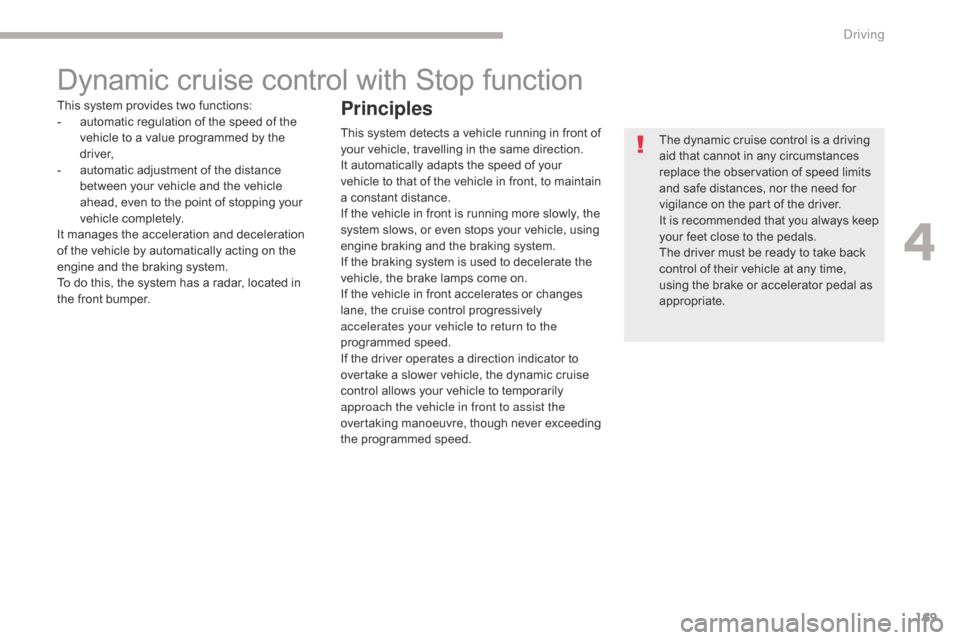
169
C4-Picasso-II_en_Chap04_conduite_ed02-2016
Dynamic cruise control with Stop function
The dynamic cruise control is a driving
aid that cannot in any circumstances
replace the observation of speed limits
and safe distances, nor the need for
vigilance on the part of the driver.
It is recommended that you always keep
your feet close to the pedals.
The driver must be ready to take back
control of their vehicle at any time,
using the brake or accelerator pedal as
appropriate.
This system provides two functions:
-
a
utomatic regulation of the speed of the
vehicle to a value programmed by the
driver,
-
a
utomatic adjustment of the distance
between your vehicle and the vehicle
ahead, even to the point of stopping your
vehicle completely.
It manages the acceleration and deceleration
of the vehicle by automatically acting on the
engine and the braking system.
To do this, the system has a radar, located in
the front bumper.
Principles
This system detects a vehicle running in front of
your vehicle, travelling in the same direction.
It automatically adapts the speed of your
vehicle to that of the vehicle in front, to maintain
a constant distance.
If the vehicle in front is running more slowly, the
system slows, or even stops your vehicle, using
engine braking and the braking system.
If the braking system is used to decelerate the
vehicle, the brake lamps come on.
If the vehicle in front accelerates or changes
lane, the cruise control progressively
accelerates your vehicle to return to the
programmed speed.
If the driver operates a direction indicator to
overtake a slower vehicle, the dynamic cruise
control allows your vehicle to temporarily
approach the vehicle in front to assist the
overtaking manoeuvre, though never exceeding
the programmed speed.
4
Driving
Page 172 of 527
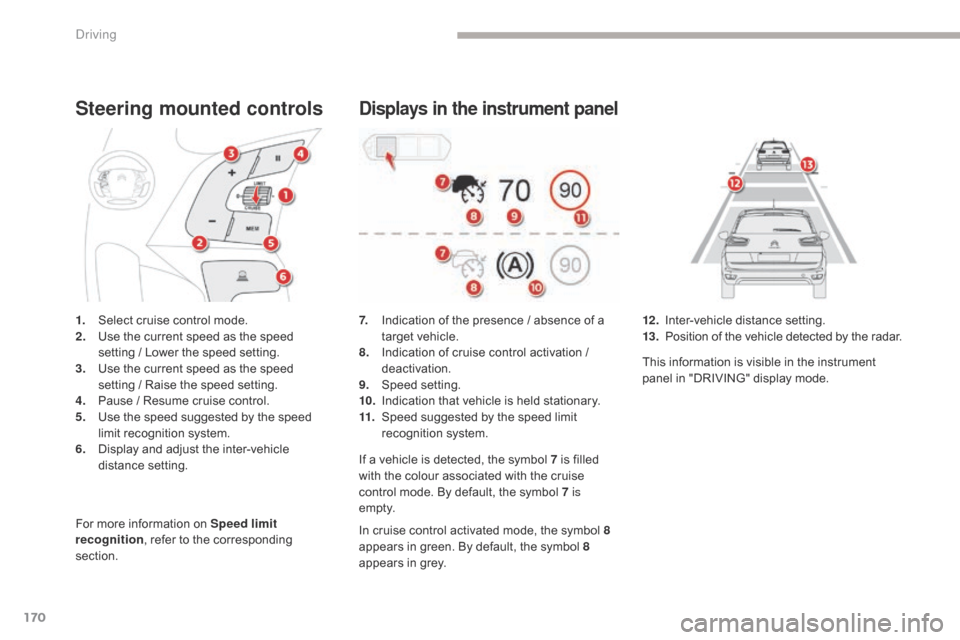
170
C4-Picasso-II_en_Chap04_conduite_ed02-2016
Steering mounted controls
1. Select cruise control mode.
2. Use the current speed as the speed
setting
/ Lower the speed setting.
3.
U
se the current speed as the speed
setting
/ Raise the speed setting.
4.
P
ause / Resume cruise control.
5.
U
se the speed suggested by the speed
limit recognition system.
6.
D
isplay and adjust the inter-vehicle
distance setting.
For more information on Speed limit
recognition , refer to the corresponding
section.
Displays in the instrument panel
7. Indication of the presence / absence of a target vehicle.
8.
I
ndication of cruise control activation /
deactivation.
9.
Spe
ed setting.
10.
I
ndication that vehicle is held stationary.
11.
S
peed suggested by the speed limit
recognition system.
If a vehicle is detected, the symbol 7
is filled
with the colour associated with the cruise
control mode. By default, the symbol 7 is
e m pt y.
In cruise control activated mode, the symbol
8
appears in green. By default, the symbol 8
appears in grey. 12 . I
nter-vehicle distance setting.
13. P osition of the vehicle detected by the radar.
This information is visible in the instrument
panel in "DRIVING" display mode.
Driving
Page 173 of 527
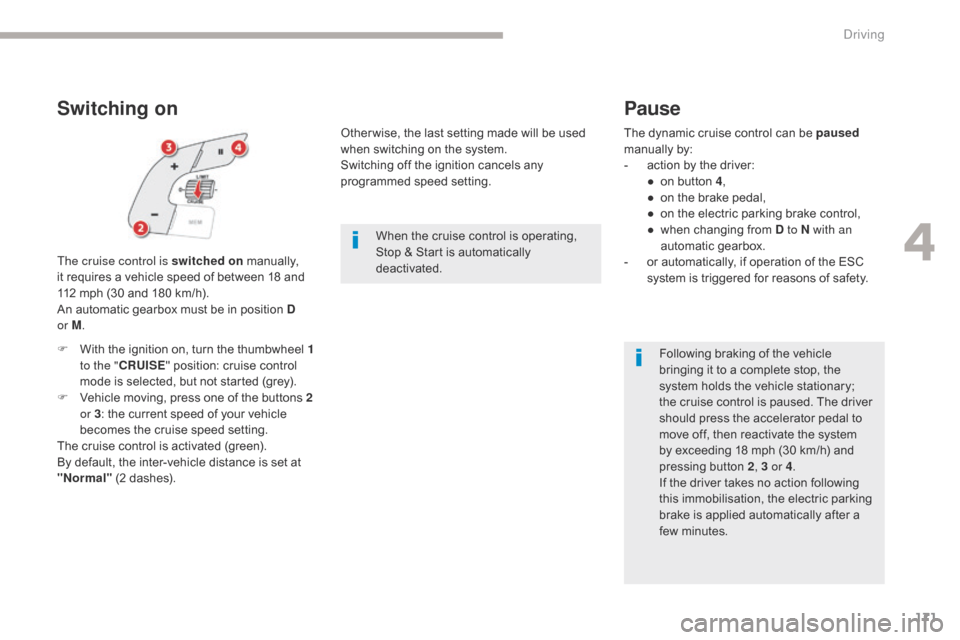
171
C4-Picasso-II_en_Chap04_conduite_ed02-2016
Switching on
The cruise control is switched on manually,
it requires a vehicle speed of between 18 and
112
mph (30 and 180 km/h).
An automatic gearbox must be in position D
or M . Other wise, the last setting made will be used
when switching on the system.
Switching off the ignition cancels any
programmed speed setting.
When the cruise control is operating,
Stop & Start is automatically
deactivated.
Pause
The dynamic cruise control can be paused
manually by:
-
a
ction by the driver:
●
o
n button 4 ,
●
o
n the brake pedal,
●
o
n the electric parking brake control,
●
w
hen changing from D to N with an
automatic gearbox.
-
o
r automatically, if operation of the ESC
system is triggered for reasons of safety.
Following braking of the vehicle
bringing it to a complete stop, the
system holds the vehicle stationary;
the cruise control is paused. The driver
should press the accelerator pedal to
move off, then reactivate the system
by exceeding 18
mph (30 km/h) and
pressing button
2, 3 or 4 .
If the driver takes no action following
this immobilisation, the electric parking
brake is applied automatically after a
few minutes.
F
W
ith the ignition on, turn the thumbwheel
1
to the " CRUISE " position: cruise control
mode is selected, but not started (grey).
F
V
ehicle moving, press one of the buttons
2
or 3 : the current speed of your vehicle
becomes the cruise speed setting.
The cruise control is activated (green).
By default, the inter-vehicle distance is set at
"Normal" (2 dashes).
4
Driving
Page 174 of 527
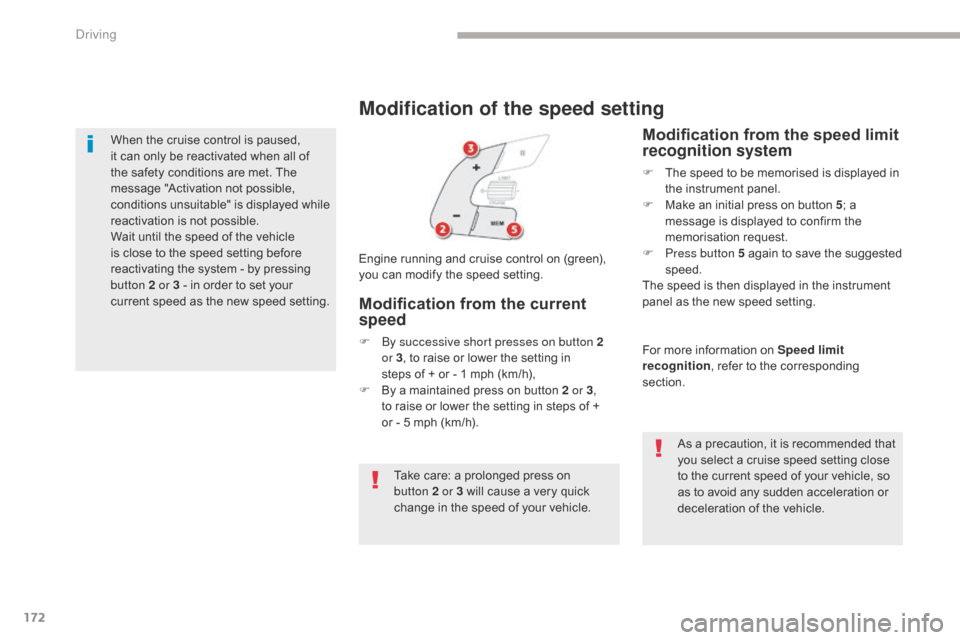
172
C4-Picasso-II_en_Chap04_conduite_ed02-2016
When the cruise control is paused,
it can only be reactivated when all of
the safety conditions are met. The
message "Activation not possible,
conditions unsuitable" is displayed while
reactivation is not possible.
Wait until the speed of the vehicle
is close to the speed setting before
reactivating the system - by pressing
button 2 or 3 - in order to set your
current speed as the new speed setting.
Modification of the speed setting
Modification from the speed limit
recognition system
F The speed to be memorised is displayed in the instrument panel.
F
M
ake an initial press on button 5 ; a
message is displayed to confirm the
memorisation request.
F
P
ress button 5 again to save the suggested
speed.
The speed is then displayed in the instrument
panel as the new speed setting.
As a precaution, it is recommended that
you select a cruise speed setting close
to the current speed of your vehicle, so
as to avoid any sudden acceleration or
deceleration of the vehicle.
For more information on Speed limit
recognition
, refer to the corresponding
section.
Engine running and cruise control on (green),
you can modify the speed setting.
Modification from the current
speed
F By successive short presses on button 2
or 3, to raise or lower the setting in
steps of + or - 1 mph (km/h),
F
B
y a maintained press on button 2 or 3 ,
to raise or lower the setting in steps of +
or
- 5 mph (km/h).
Take care: a prolonged press on
button
2 or 3 will cause a very quick
change in the speed of your vehicle.
Driving
Page 175 of 527

173
C4-Picasso-II_en_Chap04_conduite_ed02-2016
Modification of the inter-vehicle distance setting
Three predefined inter-vehicle distance settings
are offered:
-
"
Distant" (3 dashes),
-
"
Normal" (2 dashes),
-
"
Close" (1 dash). Engine running and cruise control selected
(grey), you can modify the inter-vehicle
distance setting:
F
p
ress button 6 to display the selection
screen for inter-vehicle distance,
F
p
ress button 6 repeatedly to cycle through
the predefined settings.
The selection screen closes after a
few seconds.
The modification is then taken into account.
This setting remains in memory, whatever the
state of the system and when the ignition is
switched off.
It is possible to exceed the speed setting
temporarily by depressing the accelerator
pedal.
The cruise control no longer manages the
braking system during this period.
Simply release the accelerator pedal to return
to the programmed speed.
If the programmed speed setting is exceeded,
the display of the speed setting disappears
and a message "Cruise control suspended"
is displayed until the accelerator pedal is
released.
Exceeding the programmed
setting
4
Driving
Page 176 of 527

174
70
70
C4-Picasso-II_en_Chap04_conduite_ed02-2016
Driving situations and associated alerts
To benefit from all of the information available in the instrument panel, you must first select the "DRIVING" display mode.
The following table describes the alerts and the messages displayed for the different driving situations.
The display of these alerts is not sequential.Indicator Display Associated messageComment
according to the inter-vehicle
distance selected "Cruise control paused" System paused.
No vehicle detected.
according to the inter-vehicle
distance selected "Cruise control paused" System paused.
A vehicle has been detected.
according to the inter-vehicle
distance selected "Cruise control on"
System activated.
No vehicle detected.
according to the inter-vehicle
distance selected "Cruise control on"
System activated.
A vehicle has been detected.
or "Cruise control suspended"
System activated.
The driver has temporarily taken control of the vehicle by
accelerating.
Driving
Page 177 of 527
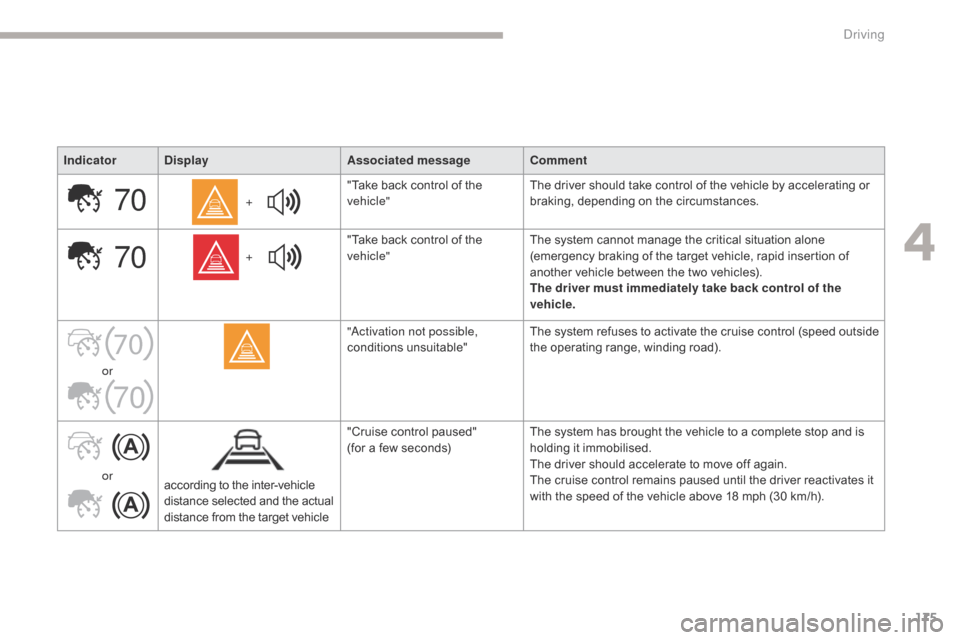
175
70
70
70
70
C4-Picasso-II_en_Chap04_conduite_ed02-2016
IndicatorDisplay Associated messageComment
+ "Take back control of the
vehicle"
The driver should take control of the vehicle by accelerating or
braking, depending on the circumstances.
+ "Take back control of the
vehicle"
The system cannot manage the critical situation alone
(emergency braking of the target vehicle, rapid insertion of
another vehicle between the two vehicles).
The driver must immediately take back control of the
vehicle.
or "Activation not possible,
conditions unsuitable"
The system refuses to activate the cruise control (speed outside
the operating range, winding road).
or according to the inter-vehicle
distance selected and the actual
distance from the target vehicle "Cruise control paused"
(for a few seconds)
The system has brought the vehicle to a complete stop and is
holding it immobilised.
The driver should accelerate to move off again.
The cruise control remains paused until the driver reactivates it
with the speed of the vehicle above 18 mph (30 km/h).
4
Driving
Page 178 of 527
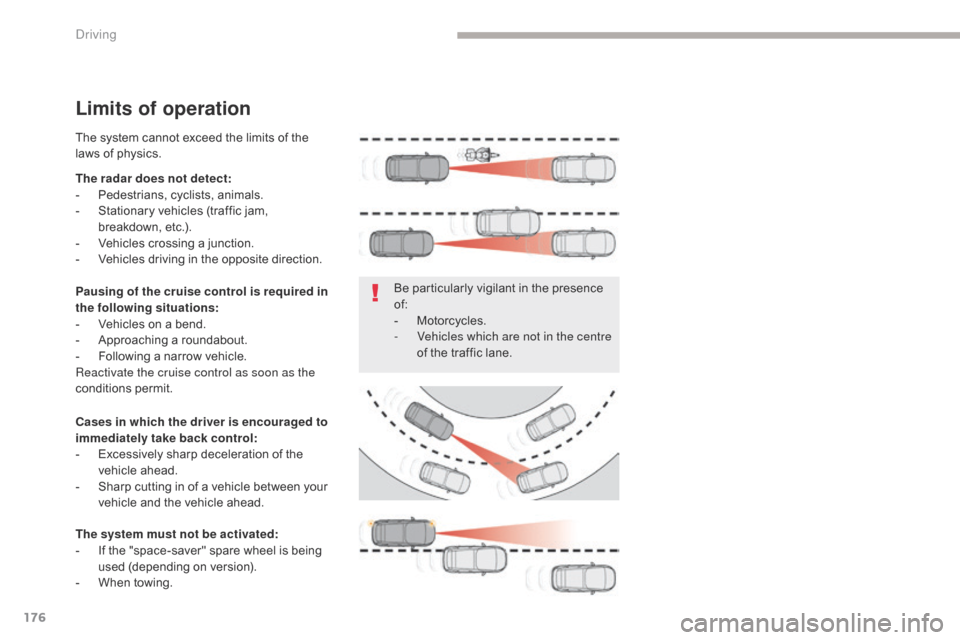
176
C4-Picasso-II_en_Chap04_conduite_ed02-2016
Limits of operation
The radar does not detect:
- Pe destrians, cyclists, animals.
-
S
tationary vehicles (traffic jam,
breakdown,
etc.).
-
V
ehicles crossing a junction.
-
V
ehicles driving in the opposite direction.
Cases in which the driver is encouraged to
immediately take back control:
-
E
xcessively sharp deceleration of the
vehicle ahead.
-
S
harp cutting in of a vehicle between your
vehicle and the vehicle ahead.
The system must not be activated:
-
I
f the "space-saver" spare wheel is being
used (depending on version).
-
W
hen towing. Be particularly vigilant in the presence
of:
-
M
otorcycles.
-
V
ehicles which are not in the centre
of the traffic lane.
Pausing of the cruise control is required in
the following situations:
-
V
ehicles on a bend.
-
A
pproaching a roundabout.
-
F
ollowing a narrow vehicle.
Reactivate the cruise control as soon as the
conditions permit. The system cannot exceed the limits of the
laws of physics.
Driving
Page 179 of 527
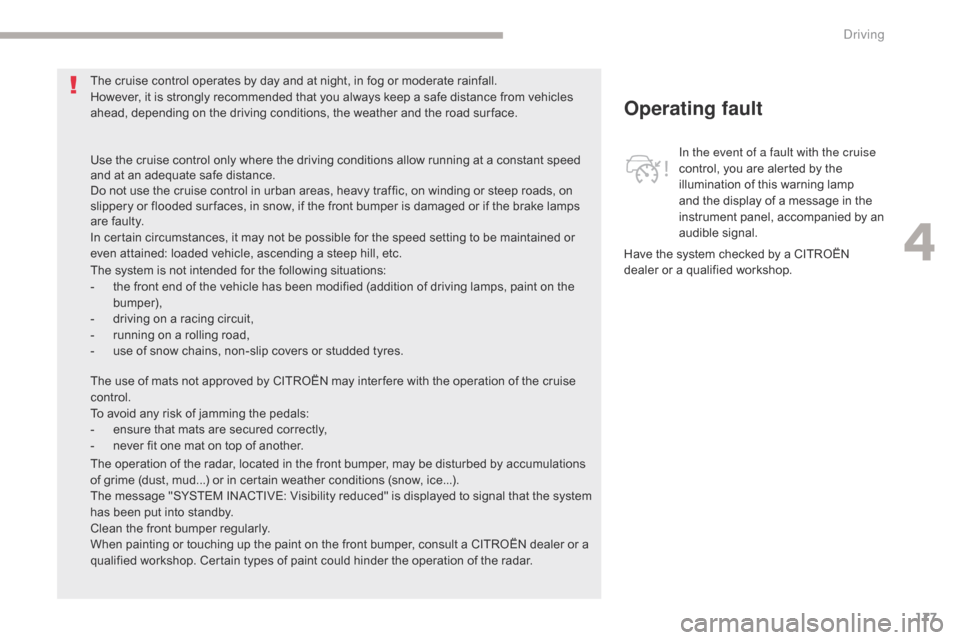
177
C4-Picasso-II_en_Chap04_conduite_ed02-2016
Operating fault
In the event of a fault with the cruise
control, you are alerted by the
illumination of this warning lamp
and the display of a message in the
instrument panel, accompanied by an
audible signal.
The cruise control operates by day and at night, in fog or moderate rainfall.
However, it is strongly recommended that you always keep a safe distance from vehicles
ahead, depending on the driving conditions, the weather and the road sur face.
Use the cruise control only where the driving conditions allow running at a constant speed
and at an adequate safe distance.
Do not use the cruise control in urban areas, heavy traffic, on winding or steep roads, on
slippery or flooded sur faces, in snow, if the front bumper is damaged or if the brake lamps
are faulty.
In certain circumstances, it may not be possible for the speed setting to be maintained or
even attained: loaded vehicle, ascending a steep hill, etc.
The system is not intended for the following situations:
-
t
he front end of the vehicle has been modified (addition of driving lamps, paint on the
bumper),
-
d
riving on a racing circuit,
-
r
unning on a rolling road,
-
u
se of snow chains, non-slip covers or studded tyres. Have the system checked by a CITROËN
dealer or a qualified workshop.
The operation of the radar, located in the front bumper, may be disturbed by accumulations
of grime (dust, mud...) or in certain weather conditions (snow, ice...).
The message "SYSTEM INACTIVE: Visibility reduced" is displayed to signal that the system
has been put into standby.
Clean the front bumper regularly.
When painting or touching up the paint on the front bumper, consult a CITROËN dealer or a
qualified workshop. Certain types of paint could hinder the operation of the radar. The use of mats not approved by CITROËN may inter fere with the operation of the cruise
control.
To avoid any risk of jamming the pedals:
-
e
nsure that mats are secured correctly,
-
n
ever fit one mat on top of another.
4
Driving
Page 180 of 527
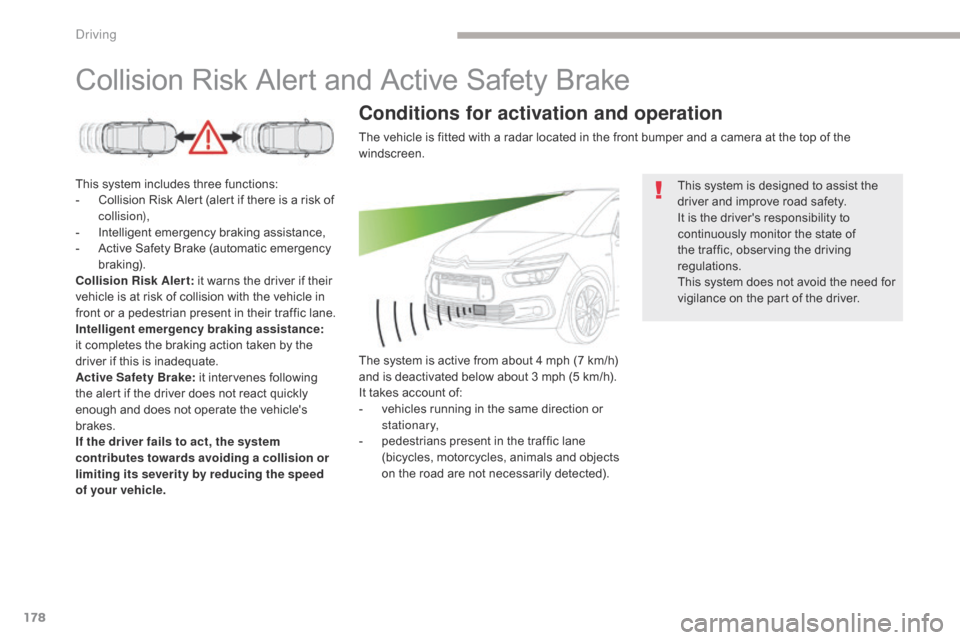
178
C4-Picasso-II_en_Chap04_conduite_ed02-2016
Collision Risk Alert and Active Safety Brake
This system includes three functions:
- C ollision Risk Alert (alert if there is a risk of
collision),
-
I
ntelligent emergency braking assistance,
-
A
ctive Safety Brake (automatic emergency
b r ak ing).
Collision Risk Alert : it warns the driver if their
vehicle is at risk of collision with the vehicle in
front or a pedestrian present in their traffic lane.
Intelligent emergency braking assistance:
it completes the braking action taken by the
driver if this is inadequate.
Active Safety Brake: it intervenes following
the alert if the driver does not react quickly
enough and does not operate the vehicle's
brakes.
If the driver fails to act, the system
contributes towards avoiding a collision or
limiting its severity by reducing the speed
of your vehicle. This system is designed to assist the
driver and improve road safety.
It is the driver's responsibility to
continuously monitor the state of
the traffic, observing the driving
regulations.
This system does not avoid the need for
vigilance on the part of the driver.
The vehicle is fitted with a radar located in the front bumper and a camera at the top of the
windscreen.
Conditions for activation and operation
The system is active from about 4 mph (7 km/h)
and is deactivated below about 3 mph (5 km/h).
It takes account of:
-
v
ehicles running in the same direction or
stationary,
-
p
edestrians present in the traffic lane
(bicycles, motorcycles, animals and objects
on the road are not necessarily detected).
Driving